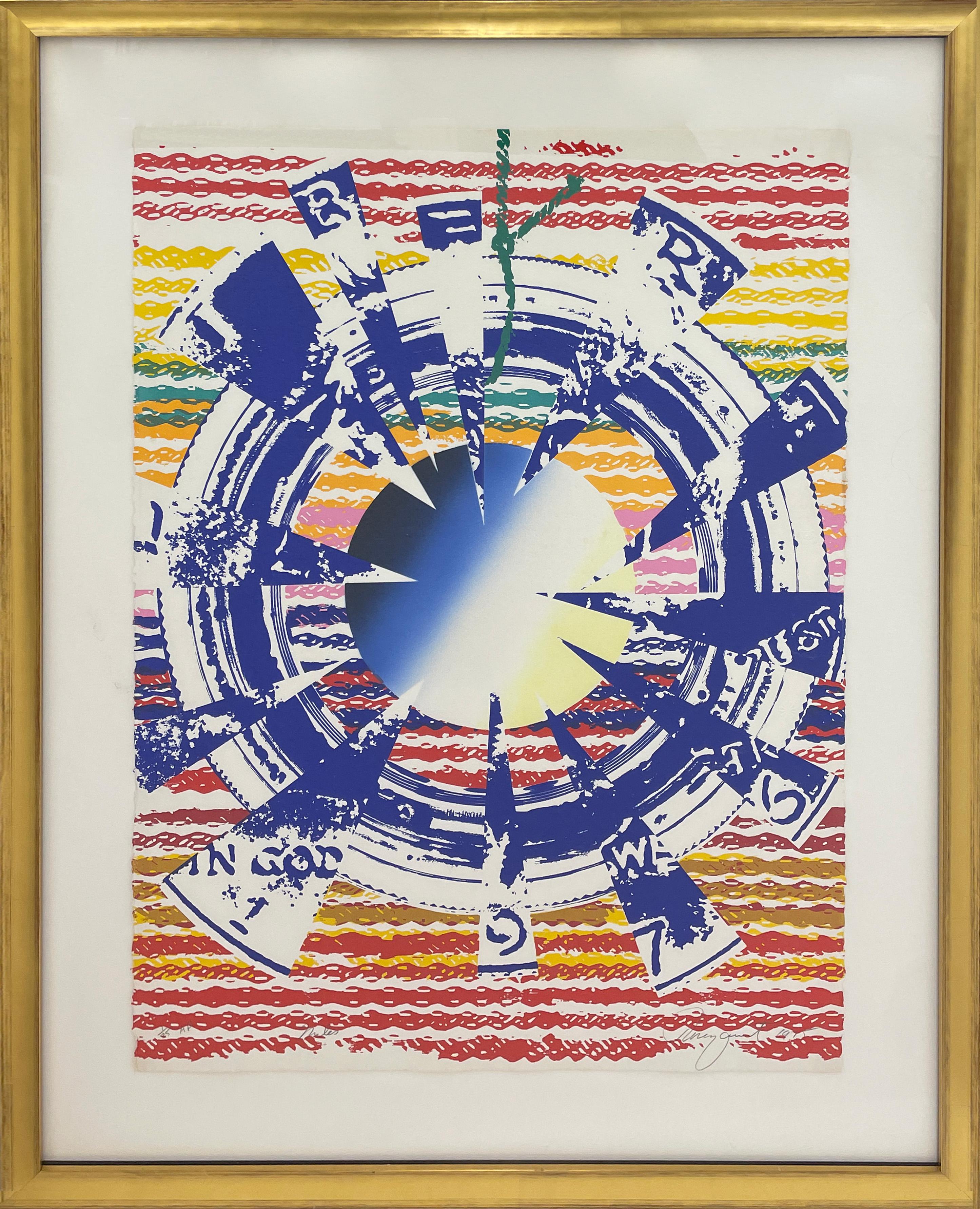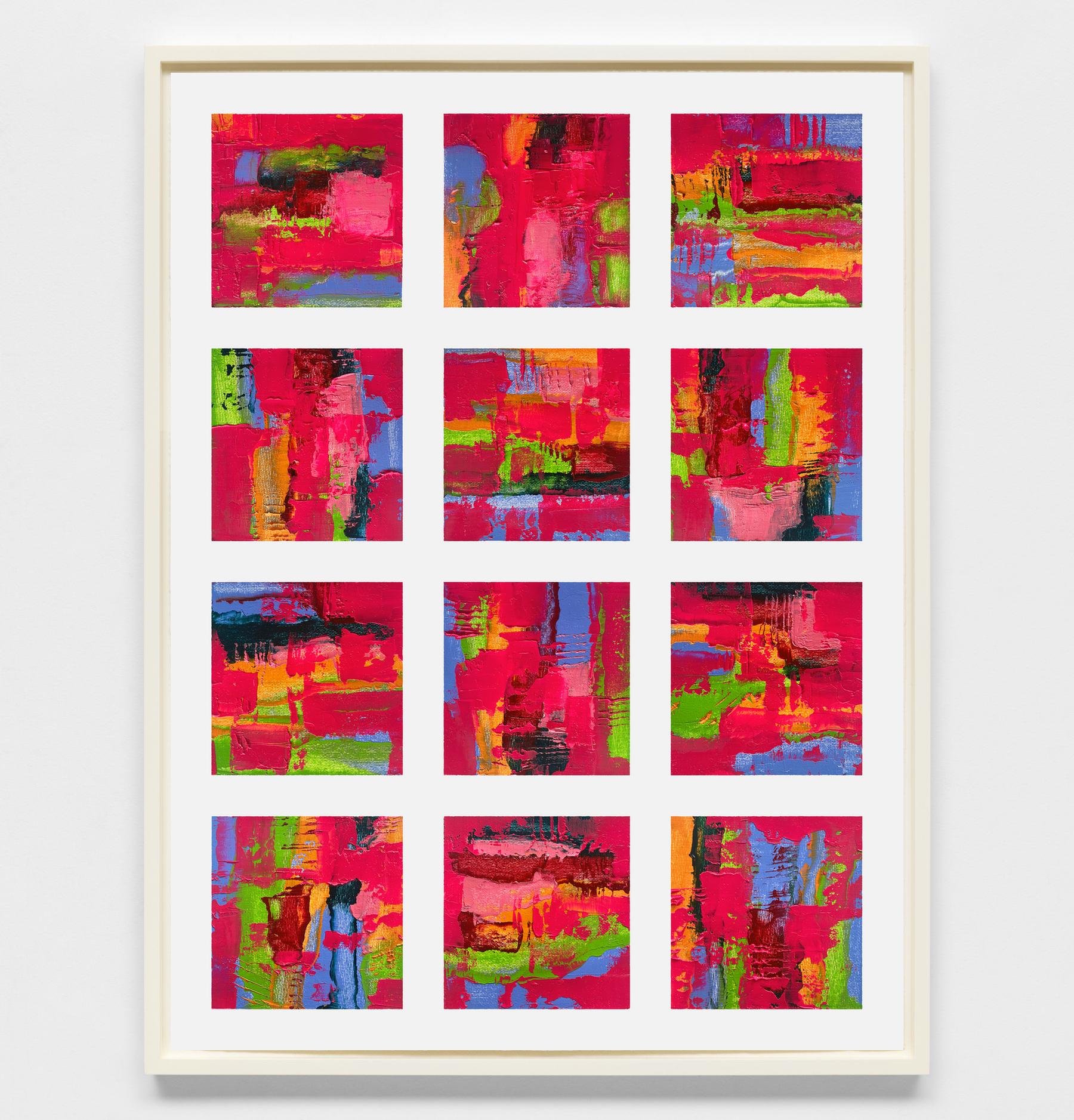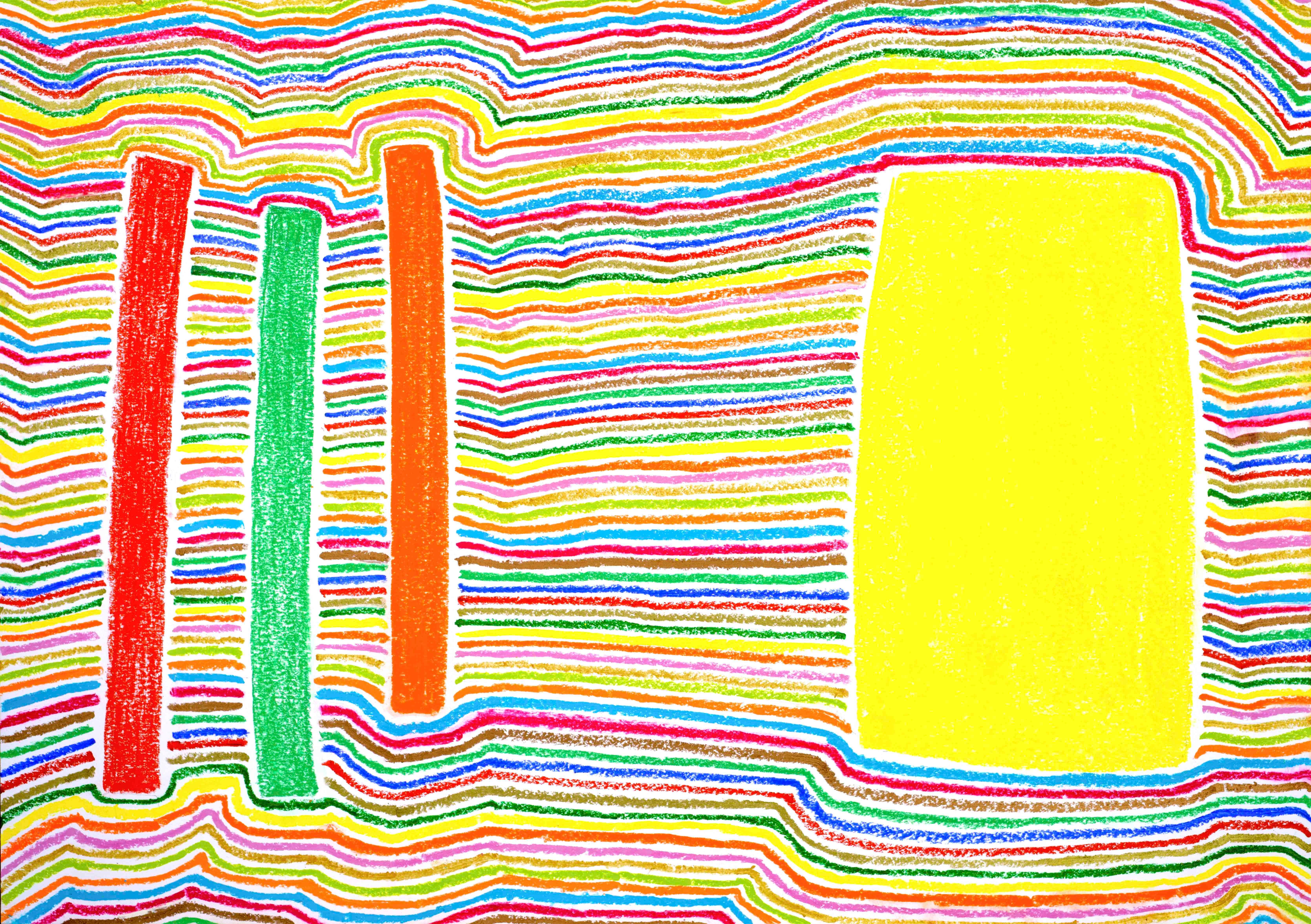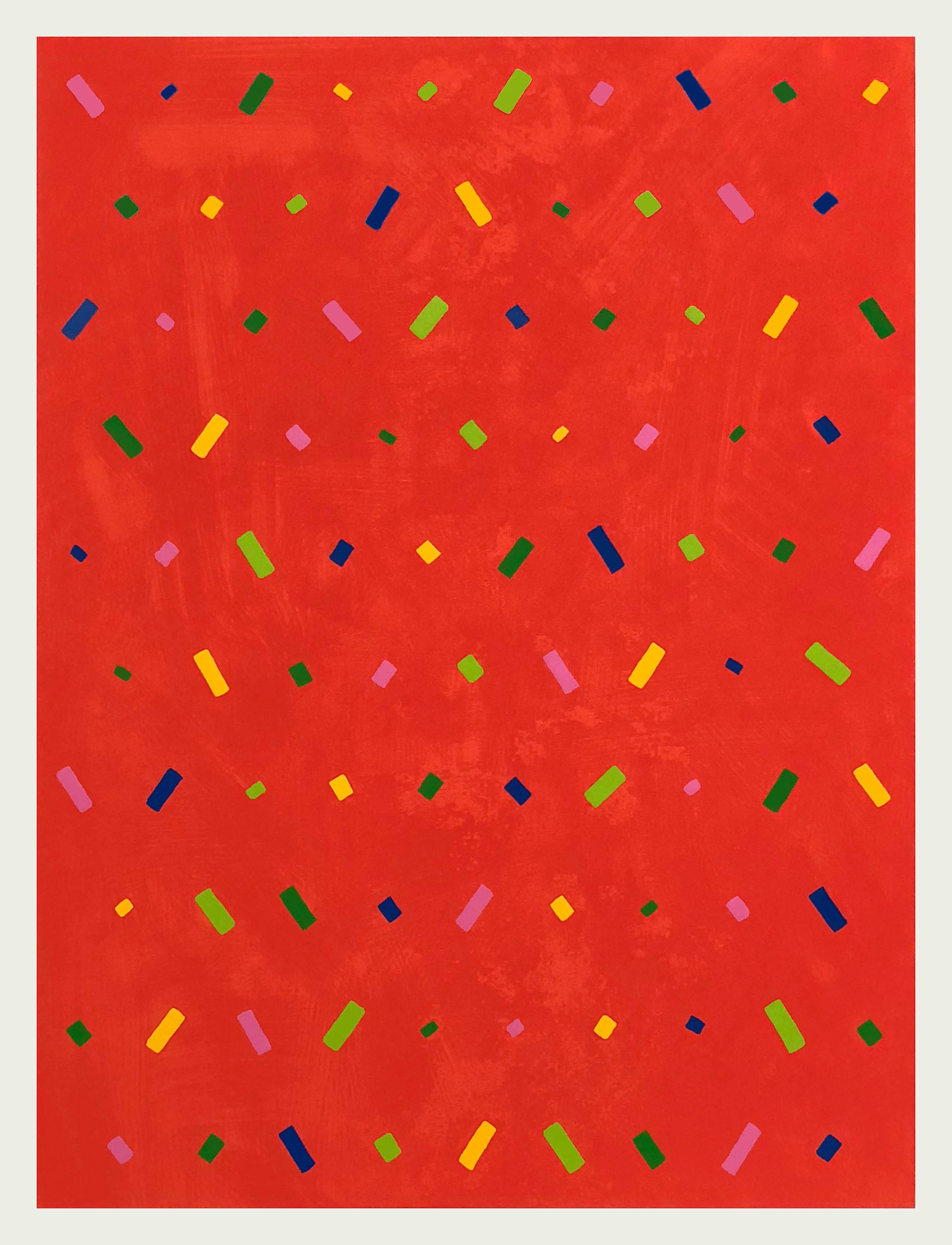Items Similar to Yellow Spike - British 60's Abstract art blue red grey COBRA Scottish artist
Want more images or videos?
Request additional images or videos from the seller
1 of 13
William GearYellow Spike - British 60's Abstract art blue red grey COBRA Scottish artist1962
1962
About the Item
An original silkscreen print by Scottish COBRA listed artist William Gear. An internationally famous abstract artist, Gear was a member of the COBRA group which was famous in the fifties and sixties for its abstract art. This trial proof 1/25 limited edition silkscreen is titled Yellow Spike and is typical of his work of the period. His prints are rare to market and his oils now command tens of thousands at auction and even higher at galley level. This is an exceptional example of a mid 20th century Scottish COBRA artwork. The colouring and condition are very good. It is a large size and signed with good provenance. Mid 20th century abstract artwork like this can be seen on display at Galleries and art fairs. This is a very good example of his work. A delightful painting.
Signed Gear '62 and titled Yellow Spike 1/25.
Provenance. PLC collection Scotland.
Condition. Large original silkscreen print. Image 27 inches by 16 inches and in very good condition. The colour is remarkable.
Housed in gallery frame which compliments the picture 40 by 28 inches, in very good condition.
William Gear (1915-1997). Few British painters have played an active role in the modern abstract movement of post-war Europe. William Gear was the most passionate and committed exception. He continued the tradition of the Edinburgh-Paris axis established by J.D. Fergusson, Samuel Peploe and others, spending vital years between 1947 and 1950 living and working in Paris. Significantly, in recent years, he received the greatest acclaim in France, Germany and the Netherlands. He was born in 1915 in Methil, Fife, into a mining family; the particular landscape of "pitheads, the sea, rocks, castles, trees, storms and poverty" marked his earliest identity with a place and probably remained the most influential to his art. Years later he recalled as a schoolboy visiting the local art gallery in Kirkcaldy and seeing 12 colourful still-lifes by Peploe. Art-history lessons during student years at Edinburgh College of Art, in particular Byzantine classes under David Talbot Rice, also influenced his concern for structure. This had as much to do with the formal language of painting as sheer delight in the medium itself. Gear never missed an opportunity to show people the merits of a well-constructed painting. On a travelling scholarship in 1937, he chose to study with Fernand Leger, described by Gear as "a keystone for me, seldom abstract, rather a degree of abstraction". The Second World War interrupted these formative years and, by 1940, Gear had joined the Royal Corps of Signals. Dispatched to the Middle East, he still had the discipline to paint - mostly works on paper of damaged landscapes - with exhibitions in Jerusalem, Tel Aviv, Cairo as well as Siena and Florence. His naturally robust and tenacious temperament was profoundly affected by visiting Bergen-Belsen, and this certainly influenced the later experiments with the black armature. As the British officer in Celle, working for the Monuments, Fine Arts and Archives Section of the Control Commission, he focused on securing the safety of the Berlin Art Collection in Schloss Celle, and organised an important series of modern art exhibitions, including the rejected work of Karl Otto Gotz. Only a few weeks before his death, this service to "democratic art and artistic freedom" was recognised in Hanover by a unique Leporello Award, appropriately instigated by fellow artists and presented by the Lower Saxony government. Demobbed in 1947, Gear headed for Paris, where he established a one-room studio at 13 Quai des Grands Augustins. This exciting period saw him gravitating towards what he called "the freer, dramatic approach of abstraction lyrique" rather then "the dogmatic hard-edged school of Mondrian and De Stijl". Within a year there were exhibitions at two of the pioneering salons and a first one-man show at the Galerie Arc en Ciel. At the same time inclusion in Cobra shows in Amsterdam and Copenhagen in 1949, alongside Constant, Corneille and Appel, underpinned his affiliation to a reinvigorated form of abstract expressionism. He worked at the time in the fluid medium of opaque water-colour, usually on card with pockets of intense colour on a white or neutral ground. While some pieces were purely abstract, others carried their own suggestion of landscape, or even a form of Celtic figuration. The same year saw an exhibition at the Betty Parsons Gallery in New York, alongside Jackson Pollock. The impact of American abstract expressionism however remained a sore subject, which in conversation was usually dismissed with a curt reminder of what he and others were already painting in Europe. The decision to return to England in 1950 was both personal and practical. Recently married to Charlotte Chertok, and with a baby, he had already secured in 1948 the first of a series of London exhibitions with the Gimpel Fils Gallery. The atmosphere surrounding the Festival of Britain also appeared to offer fresh opportunities. Notoriously, Gear was awarded one of the Festival of Britain Purchase Prizes for Autumn Landscape, a large oil on canvas which took six difficult months to complete. The event produced written questions and answers in the House of Commons and a tirade of abuse from the national press, not to mention a topic for debate on the radio programme Any Questions. While the episode made him a household name, the longer-term effects were, arguably, more detrimental. He chose not to live in London or join fellow abstract artists in St Ives, preferring the independence of a village in Kent between 1953 and 1958. This period saw the continued development of large landscape structures, as well as "side-roads" into sculptural subjects and minimalist colour paintings, which openly acknowledged the influence of Nicolas de Stael. These works have still to be properly exhibited. Mau-Mau (1953), for example, painted for the Contemporary Art Society but at the last minute withdrawn from display at the Tate Gallery, has its first London showing in the current golden jubilee exhibition at the Redfern Gallery. Gear was out of critical favour for most of the 1960s and 1970s. He exhibited more irregularly, despite returning to the use of dark structures broken by selected movements and light-inflected primary colours. While contemporaries questioned his move to Eastbourne as Curator of the Towner Art Gallery (1958-64), Gear's response was to take on the Purchase Committee. He changed the local authority's collection policy from Victorian and local views to securing the foundation of a major collection of post-war British art. His move to Birmingham came with the appointment as Head of the Faculty of Fine Art, Birmingham College of Art, in 1964, a post held until retirement in 1975, by which time he had become increasingly un- interested in the growing bureaucracy surrounding art education. His support and encouragement to artists living in Birmingham however continued with the purchases made for Birmingham Museums and Art Gallery on behalf of the Friends organisation (1987-94) as well as for his own personal collection. Most recently he instigated the idea of a gallery of modern art in Birmingham. Fortunately, the last 15 years have also gone some way to reverse the years of neglect. Gear and Stephen Gilbert (also Scottish) were the only British artists included in the major Cobra 1948-51 exhibition at the Musee d'Art Moderne, Paris, in 1982. The Cobra enthusiast Karel van Stuijvenberg has been a prominent patron and, in 1995, Gear took delight in attending the opening of the Cobra Museum of Modern Art in Amstelveen, near Amsterdam. He was equally proud of his long overdue election to the Royal Academy in 1995, and in the last years relished working with the fluidity and strong colours of oil stick. Tessa Sidey. Exhibited and held by worldwide galleries including The Tate.
- Creator:William Gear (1915-1997, Scottish)
- Creation Year:1962
- Dimensions:Height: 40 in (101.6 cm)Width: 28 in (71.12 cm)Depth: 2 in (5.08 cm)
- Medium:
- Movement & Style:
- Period:
- Condition:
- Gallery Location:London, GB
- Reference Number:1stDibs: LU853113244572
About the Seller
5.0
Platinum Seller
These expertly vetted sellers are 1stDibs' most experienced sellers and are rated highest by our customers.
1stDibs seller since 2018
398 sales on 1stDibs
Typical response time: <1 hour
- ShippingRetrieving quote...Ships From: London, United Kingdom
- Return PolicyA return for this item may be initiated within 14 days of delivery.
More From This SellerView All
- Landscape with White Bird - Welsh 1950's Abstract art oil painting natureBy Glyn MorganLocated in London, GBA Welsh artist, Morgan studied at Cardiff College of Art under Ceri Richards. He was a renowned imaginative artist and friend of Cedric Morris. He was influenced by the Benton End ar...Category
1950s Abstract Abstract Paintings
MaterialsOil
- Edge of the Universe - British Abstract art watercolour painting St Ives NewlynLocated in London, GBThis British abstract watercolour is by noted artist David Gwyther Irwin. Painted circa 1990 it is one of a series of paintings and is entitled Edge of the Universe. A superb paintin...Category
1990s Abstract Abstract Drawings and Watercolors
MaterialsWatercolor
- New Vision - Canadian Abstract Expressionist art 60s oil painting landscape pinkBy William John Bertram NewcombeLocated in London, GBAn original large abstract oil on canvas by British Canadian artist William John Bertram Newcombe. This stunning abstract expressionist oil painting is a bold, adventurous and conf...Category
20th Century Abstract Expressionist Abstract Paintings
MaterialsMixed Media, Oil
- Essex Landscape - British 20th century Abstract art landscape oil paintingBy Lawrence SelfLocated in London, GBA large oil on canvas by noted abstract landscape artist Lawrence Self. Painted circa 1970 this is a fine large oil of an Essex landscape. A superb painting with lovely brushwork and...Category
20th Century Abstract Landscape Paintings
MaterialsOil
- Lonistum 1961 - Canadian British Abstract art oil paintingBy William John Bertram NewcombeLocated in London, GBAn original large abstract oil on canvas by British Canadian artist William John Bertram Newcombe. This stunning abstract expressionist oil in blues and greys is a bold, adventurous ...Category
1960s Abstract Abstract Paintings
MaterialsMixed Media, Oil
- Fifties Abstract - British 1954 abstract art oil painting Slade School artistLocated in London, GBThis superb British 1950's abstract oil on board painting is by noted Slade School trained contemporary artist Leo Davy. Davy was born in Yorkshire but settled in Cornwall in 1968 an...Category
1950s Abstract Abstract Paintings
MaterialsOil
You May Also Like
- Miles from America by James RosenquistBy James RosenquistLocated in Hinsdale, ILJAMES ROSENQUIST Miles from America Screenprint in colors with pochoir on Arches paper, 1975 Signed and numbered and titled in pencil along lower edge Edition number AP 1/25 (asi...Category
1970s Abstract Expressionist Abstract Prints
MaterialsScreen
- "The Color of Mind and Muscle" by James RosenquistBy James RosenquistLocated in Hinsdale, ILJames Rosenquist (1933-2017) "Color of Mind and Muscle" Screenprint in colors on wove paper, 1996 31-1/2 x 25-3/4 inches (80 x 65.4 cm) (sheet) A.P. 7/10 edition of 30 Signed, numb...Category
1990s Abstract Expressionist Abstract Prints
MaterialsScreen
- PanoramaBy Osvaldo MariscottiLocated in New York, NY2021 Screenprint in colors, on Rives BFK paper Image/sheet: 40 x 30 in. (101.6 x 76.2 cm) Edition of 100 Signed, dated and numbered in pencil, lower margin Unframed, mint conditionCategory
2010s Abstract Abstract Prints
MaterialsPaper, Screen
- TimelineBy Osvaldo MariscottiLocated in New York, NY2020 Set of three 18-color screenprints on Rives BFK paper Sheet: 32 7/10 x 40 in. (83.1 x 101.6 cm), each Edition of 55 Each signed, dated and numbered in pencil, lower margin Unfra...Category
2010s Abstract Abstract Prints
MaterialsPaper, Screen
- FocusBy Osvaldo MariscottiLocated in New York, NY2020 Screenprint in colors, on Arches paper Sheet: 28 1/2 x 38 in. (72.4 x 96.5 cm) Edition of 55 Signed, dated and numbered in pencil, lower margin Unframed, mint conditionCategory
2010s Abstract Abstract Prints
MaterialsPaper, Screen
- Untitled (Red OM18-0302)By Osvaldo MariscottiLocated in New York, NY2018 Screenprint in colors, on Arches Aquarelle paper Sheet: 34 x 26 in. (86.4 x 66 cm) Edition of 40 + 15AP Signed, dated and numbered in pencil, lower marginCategory
2010s Abstract Abstract Prints
MaterialsPaper, Screen





